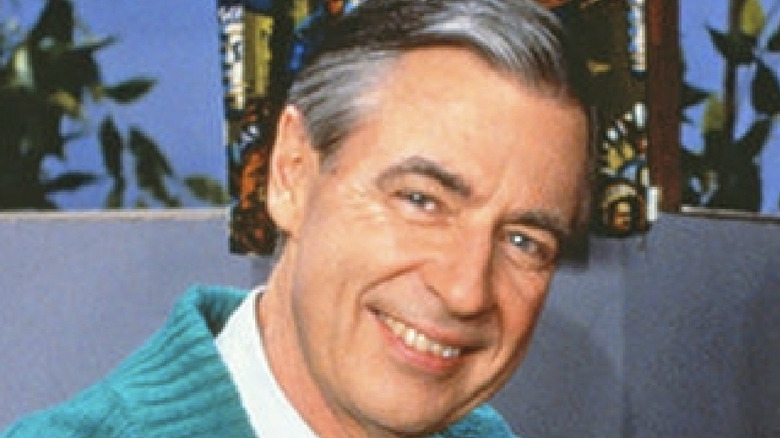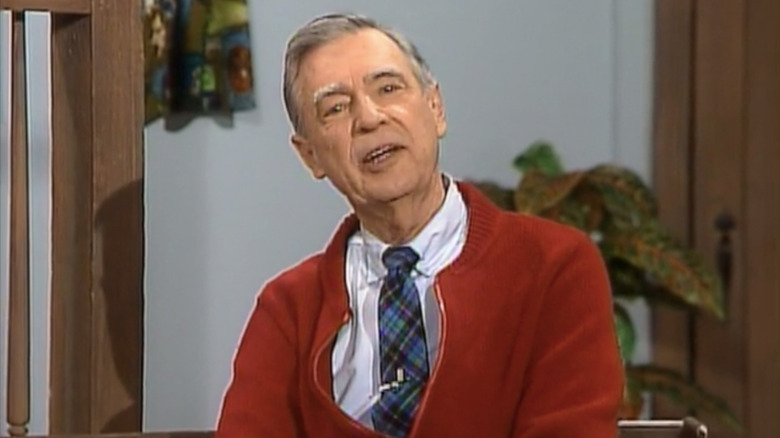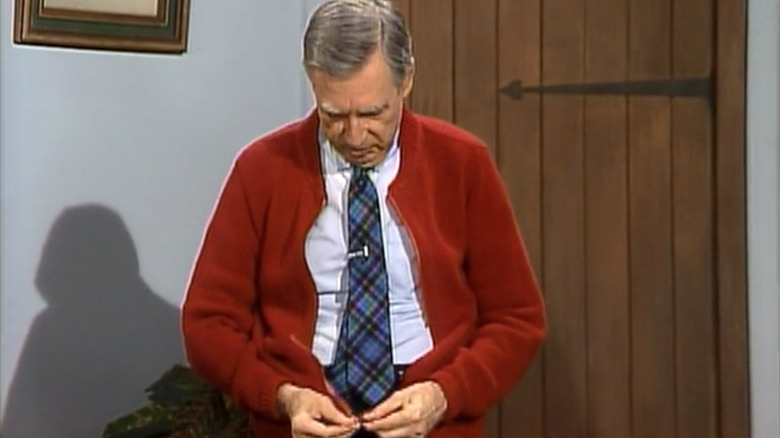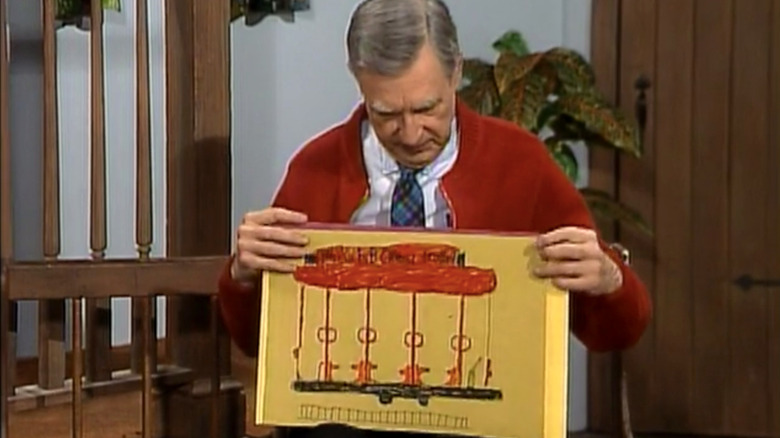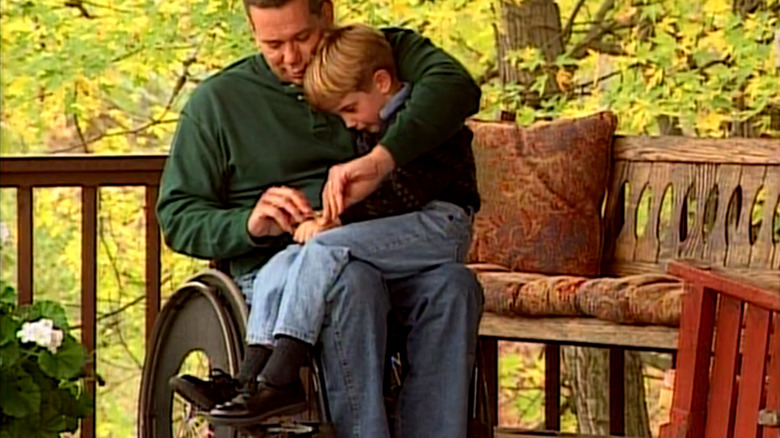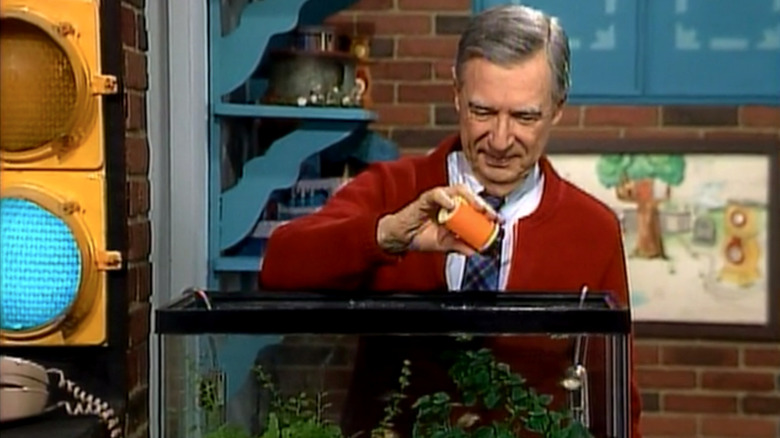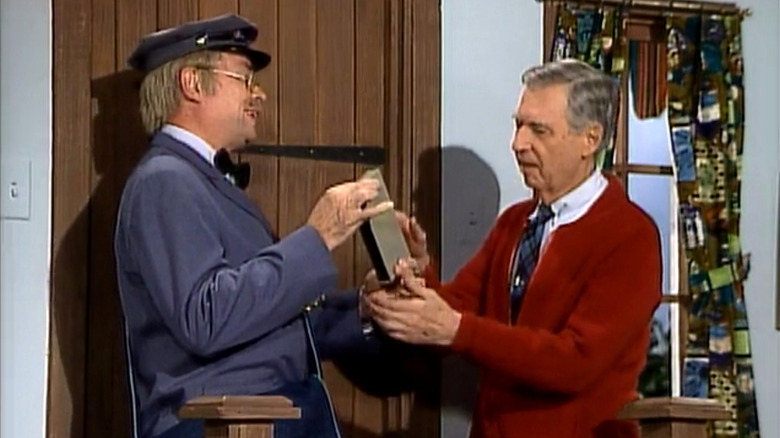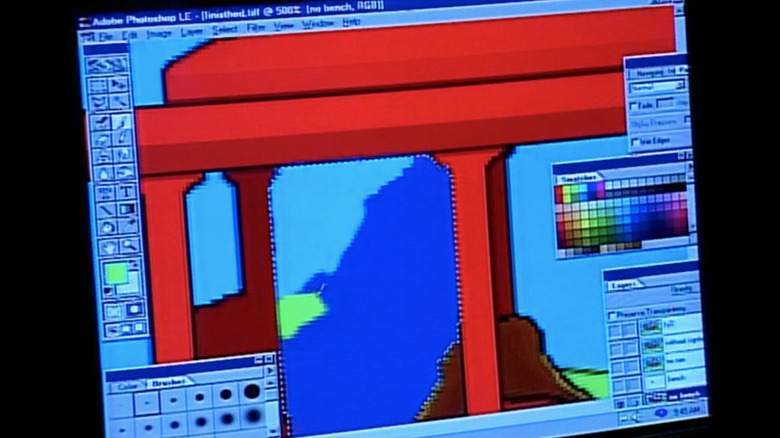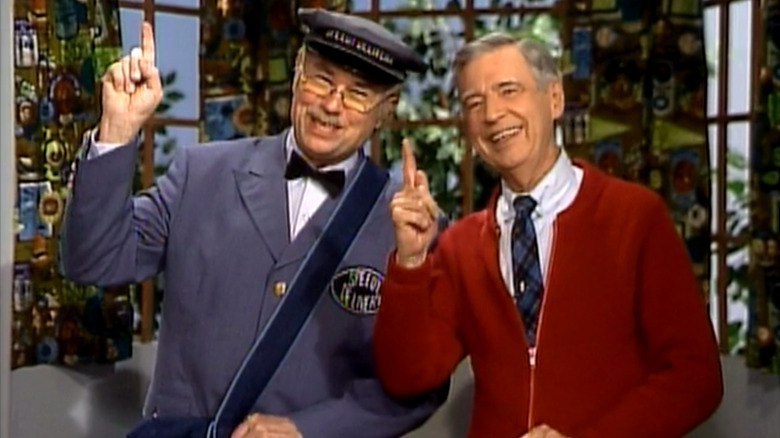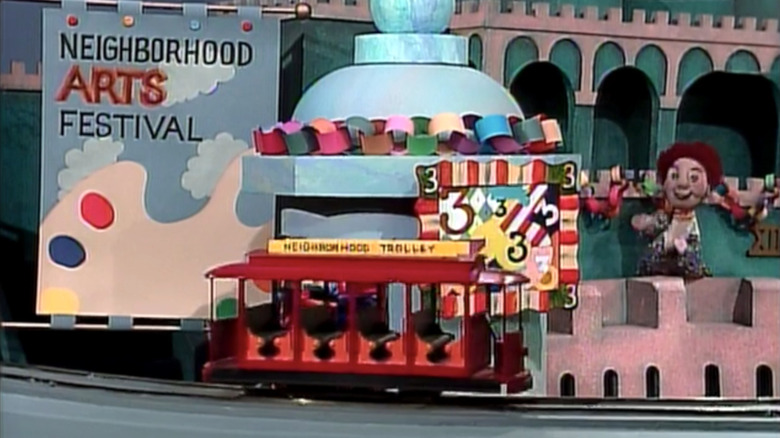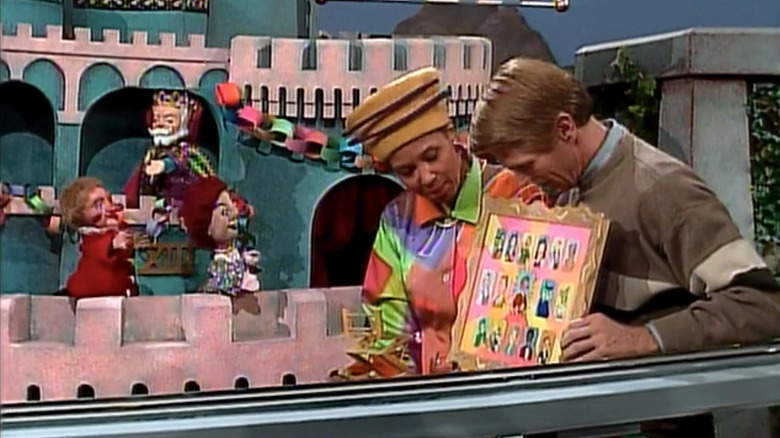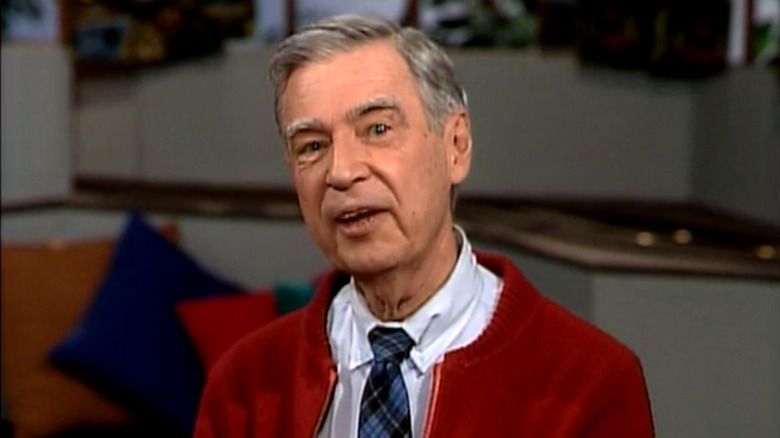What The Last Episode Of Mister Rogers' Neighborhood Was Like
Multiple decades after his show went off the air, the name Mister Rogers remains synonymous with children's television. Fred Rogers had initially developed his show in Canada in 1963, where it continued for four years, until he quit and brought the show back to his home in Pittsburgh. Beginning in 1968, the Pittsburgh-produced incarnation ran daily on public television across the U.S. Other than a hiatus Rogers took in the late '70s (during which reruns kept airing), "Mister Rogers' Neighborhood" ran continually until 2001, when a 73-year-old Fred Rogers finally hung up his cardigan.
"Mister Rogers' Neighborhood" was a deceptively simple show in which Fred Rogers hung out in a house that was a simple TV set, speaking directly and frankly to the children watching at home, as he sang songs and taught lessons about life. His focus was never math and reading — that was more "Sesame Street" territory — it was instead about dealing with emotions, facing life's problems, and generally being a good neighbor to those around you. He would take visitors along to neighborhood businesses, to visit friends, and on tours of factories and the like. Each episode also featured a visit to the Neighborhood of Make-Believe, a land occupied by puppets (mostly performed by Rogers himself) who would often teach the same lessons in the manner of fables.
When the show ended in 2001, there was no big finale, and no "farewell special." After 33 years on the air, there was just a final episode. That episode, however, was nonetheless special for those few who knew the significance of what was unfolding. Let's look back now at everything that happened that day, in the final episode of "Mister Rogers' Neighborhood."
Mister Rogers never acknowledges that it's the final episode
If you didn't know going in that this was going to be the final episode of the series, Mister Rogers wasn't going to tell you. After all, PBS would still be running the show in reruns the next week, so a big farewell would likely just be confusing to the little kids who made up his core audience; for the children who were particularly attached, Mister Rogers saying goodbye as if he was never coming back might lead to some tears. And as we all know, Fred Rogers always thought of the children first and foremost.
So as you watch the episode, a stalwart Mister Rogers makes his way through with the same familiar touchstones, the same warmth and kindness as always, never letting on that this is the end of an era.
Instead, the focus of the episode is concluding a five-part series called "Celebrating the Arts." These week-long themed series were a feature of the show throughout its run, and Rogers was always good at carrying the theme from Monday to Friday without making kids feel like they missed anything if they weren't home to watch on Tuesday or Wednesday. If "Celebrating the Arts" seems particularly broad, well, it enables the end of the series to feature a series of fitting moments without being overt about the subtext of finality.
He shows his age zipping his zipper
Before we talk about all the planned segments of the show, we need just a moment to talk about something that wasn't at all intended. In every episode of the series, Mister Rogers would come in and change out of his suit jacket and dress shoes and into a zip-up cardigan and sneakers. Viewers of the show weren't generally part of Fred Rogers' more formal generation (he was born in 1928), so this need to have a fancier out-in-the-world outfit that you would trade for more comfortable trappings upon arriving home may have seemed a bit strange to some, but every child who watched became accustomed to the ritual, and it became an unmistakable aspect of the show.
In this final episode, however, he has a little trouble. It's only a quick moment, but Mister Rogers doesn't get the zipper on his cardigan to work on his first try. He can't get the bottom pieces to link up, so the zipper won't move upwards like it's suppose to. He laughs gently to himself, gets it on the second try, and then moves the zipper up and down triumphantly before moving on. As quick as it is, it's a genuine moment of vulnerability. He may still have all his charisma and ability to connect with small children, but this is a 73-year-old man, and nothing comes as easy to him as it once did.
Children's drawings of Trolley
The first segment of the episode is simply Mister Rogers showing off a series of colorful drawings that different small children have made of Trolley. That's not just any trolley, remember, it's the sentient trolley — given the proper name Trolley — that has guided viewers into the Neighborhood of Make-Believe in every episode, and has conversations with Mister Rogers and his puppets by moving back and forth on the track and using its bell as a voice.
Mister Rogers explains that he's showing us the Trolley drawings to demonstrate how different people have unique ways of drawing the same thing, proving how special each person is, and how one-of-a-kind their perspective is on the world. The children's drawings are wildly different in shape, size, and color, while all bearing some resemblance to the real Trolley.
That's not all the drawings display, however. They also demonstrate how much love the children who watch this show have for this faceless object — just a miniature trolley on a track — that Rogers has imbued with life and personality simply by talking to it as if it were a person. If this is how much they love Trolley, you can just imagine how much they love Mister Rogers himself.
All kinds of families showing their love
Mister Rogers segues from those pictures of Trolley into talking about different ways that people show their love for one another, of which making art is only one. That leads to a montage of different families doing different things to show their love. It's a simple, wordless montage of the type that was common on "Mister Rogers' Neighborhood," but it's nonetheless striking for a couple of reasons.
First, it offers a sincerity that's rare in children's television. It's impossible to know the exact circumstances of these scenes being filmed, but nothing looks staged or rehearsed. Children picking up toys, helping each other with homework, or helping their mom rake leaves, all seem to be genuine people living their lives just as they would be if there weren't cameras around.
Secondly, there's a casual diversity to the families on display that would feel pretty standard today, but was much less so at the time. An Asian-American mom shows her young daughters how to make tempura vegetables. A Black grandmother shows her grandson how to wash dishes. A white father in a wheelchair puts a Band-Aid on his son's hand and comforts him. There aren't any same-sex parents, which we might expect to see if this montage was made today (although we still might not, depending on where it aired), but there's very little else that feels dated.
When the montage ends, fading from a mom laughing on the floor with her two kids, Mister Rogers' smile is every bit as sincere as theirs.
Feeding the fish one last time
Next, Mister Rogers shows some love for his tank of fish by feeding them. All the fish swim around rapidly as the flakes of food sink into the water, and he comments that they seem to be dancing. It's allowing these little moments, like feeding the fish, to breathe that really makes this series feel unique, especially from today's fast-paced perspective. He always mentions aloud when he's feeding the fish, because a young blind girl once wrote to him and asked him to let her know, so she'd feel reassured that the fish were being fed.
Another kids' show probably would have named the fish, attempting to attribute humanlike personalities to them, and made the whole thing much more complicated. But on "Mister Rogers' Neighborhood," it's enough that he has a real fish tank, that the fish are beautiful to watch — and that we feed them every day, together.
A Speedy Delivery
As Mister Rogers is standing at the fish tank, there's a knock on the door, which turns out to be Mister McFeely (David Newell) the "Speedy Delivery" man who had frequently brought packages and other surprises since taking on the role in 1968. This time he's bringing something of his own creation — a videotape he made of many different kinds of artists making art. It's been previously established on the show that Mister McFeely likes to take pictures and videos when he's not delivering things speedily, so he's the perfect onscreen source for this next montage.
Mister Rogers makes a big deal of the fact that McFeely made the video himself — that the video of artists making their art is itself an object of art, and that a delivery man can be an artist in his spare time. Together they take the tape to Picture Picture — the wall-mounted video screen in Mister Rogers' living room that's often disguised as a painting — and press play.
Artists making all kinds of art
As for the video, it's similar in structure to the earlier family-oriented one, but now focused on artists in action, and with a similar emphasis on diversity. There's some classical guitar, a man doing traditional Southwestern weaving on a loom, a white pianist and a Black trumpeter playing jazz together, a pair of Asian ballet dancers, a woman painting a sculpture of a cat, and a group of Native-American children doing a traditional dance in Eagle costumes.
The most interesting — and certainly the most 2001 — part of the video is a sequence of a man using Adobe Photoshop to make digital art: a picture of Trolley, no less! It's a bit date crude by today's standards, but he shows the depth of color options, the variety of brushes, and how parts of the image can be copied and pasted to create repeating patterns. Even in its final episode, "Mister Rogers' Neighborhood" was as focused on the future as it was on the past. After all, the future is where Mister Rogers' core audience would be spending most of their lives.
Mister McFeely's Goodbye Song
After the video, as Mister McFeely prepares to leave for what he and Mister Rogers both clearly know will be the final time, he sings his "Speedy Delivery" song, an upbeat jingle about how he can bring anyone anything they might need or want. After McFeely does the song once by himself, Mister Rogers asks if he and his "neighbor" (meaning the kids at home) can sing the song with him. Then they do the same song all the way through again, both mirroring each other's hand motions and seeming like two old friends having a great time together.
This is just another example of how this episode has a sense of finality to it, despite never declaring itself a finale. Mister Rogers obviously doesn't say "let's sing Mister McFeely's song with him, since this is his last visit," but he knows that to be true, and it's there in his performance, just as it is in Newell's as Mister McFeely. Interestingly, as Mister McFeely's almost out the door, Mister Rogers tells him, "Congratulations," and receives thanks in turn, but there's no explanation of what the congrats are for. His retirement, perhaps?
An Arts Festival in the Neighborhood of Make Believe
With Mister McFeely gone, it's time to check in on the Neighborhood of Make-Believe, the kingdom where all of Mister Rogers' puppets live. As he brings out Trolley to take us there, Mister Rogers reminds viewers that they're having a Royal Arts Festival, and that the other puppets recently learned that Lady Elaine Fairchilde (who had traditionally been the meanest puppet in the neighborhood) was only hurting people's feelings because her feelings had been hurt first.
Trolley goes through the tunnel into the Neighborhood of Make-Believe, which is decorated for the Arts Festival. Betty Okonak Templeton, a puppet with a Southern accent (performed by Michael Horton), greets Trolley, offers a brief tour of some of the art on display, and explains that she's looking for Lady Elaine.
We then cut to the rocking chair factory home of Corney S. Pecially, a beaver puppet (performed by Fred Rogers) who is showing off his Arts Festival contribution to Mayor Maggie Stewart, one of the local humans. An expert woodworker, Corney has made what he describes as "an artistic chair," a puppet-sized rocking chair with a unique shape that rocks on its own with the push of a button. Mayor Maggie is so impressed with the chair that Corney offers to give it to her when the festival is over.
As is typical with the Neighborhood of Make-Believe, this sequence is a wild departure from the simple, peaceful atmosphere of Mister Rogers' house. Suddenly everything is bright colors, talking animals, and whimsy. But as we'll soon see, Rogers used this neighborhood frequently to create touching emotional and educational moments.
The Redemption of Lady Elaine Fairchilde
For much of the run of "Mister Rogers' Neighborhood," Lady Elaine Fairchilde was the closest thing the Neighborhood of Make-Believe had to an ongoing villain. She was never evil, of course, but she was definitely mean, making fun of the other characters and showing no respect for the authority of King Friday the Thirteenth, ruler of the Neighborhood. A cranky neighbor who bears a noticeable resemblance to the traditional chaos-creating puppet character Mister Punch (with ruby-red cheeks and an oversized nose tipped in the same color), Lady Elaine made her first appearance way back in Episode 5 of the series, and Fred Rogers lovingly named her after his adopted sister.
Here in the last episode, however, she's experiencing a change of heart. When Betty finally finds her, the two of them arrive at King Friday's castle just after Mayor Maggie shows up with Corney's chair, which the King finds very impressive. One of the other humans, Chuck "Neighbor" Aber, arrives with his unique contribution to the festival: a small replica of Trolley that parachutes gracefully from the sky.
Lady Elaine has also brought a piece of art she created: a large frame, containing mini-portraits of everyone in the Neighborhood of Make-Believe. For a character who has previously wanted nothing to do with her neighbors, this is a big deal. As Lady Elaine explains, she has learned to embrace the things that make her unique, like her big nose, and no longer fears being teased. Thus, she no longer feels the need to be mean to everyone. She also gets to be the judge of the Arts Festival, and declares that every single entry shall get First Prize.
One last goodbye song
After Trolley brings us back to the "real" world, Mister Rogers suggests that viewers can have their own arts festivals, featuring whatever kind of art they enjoy making. He says that one of the ways you'll know you're grown up is when you feel sure that what your doing is good for yourself, your friends, and your community. It's hard to say if that exactly reflects how grownups live and make choices today — but then, as today, Mister Rogers wants us to be our bests selves. It sure is nice to remember how warmly Mister Rogers regarded us and our intentions. To emphasize this very point, he sings a little song about how proud he is of his viewers.
By now the show's nearly over, and Mister Rogers returns to the drawings of Trolley, suggesting that viewers can make their own, which will be unique from all the others. Then he sings his usual goodbye song, about what a good feeling it is to be alive. And as he always did, he promises to return "when the week is new," and spend more time with his neighbors.
Even though the show was ending, Fred Rogers knew his show would live on in reruns for years to come. It does live on today, via streaming and the Internet, and other ways he never could have imagined. Fred Rogers himself died less than two years after filming the episode.
A pioneer of television and an early advocate of video recording, Mister Rogers probably wouldn't be surprised that we're still watching and talking about his show decades after it ended. He would be proud, however — just as he was always proud of all of us, and never hesitated to let us know.
